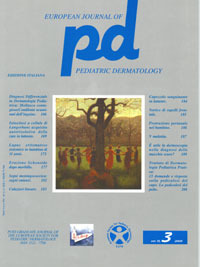Cutaneous involvement in meningococcal sepsis.
Downloads
How to Cite
Bonifazi E. 2005. Cutaneous involvement in meningococcal sepsis. Eur. J. Pediat. Dermatol. 15 (3): 182.
pp. 182
Abstract
Meningococcal sepsis is the most frequent cause of purpura fulminans (1). From a clinical point of view, acrolocated erythematous lesions are rapidly followed by necrotic-hemorrhagic blue-blackish areas sharply demarcated by an erythematous border from the healthy skin (2). The lesions, sometimes consisting of blisters, can deepen till to the osseous tissue. Laboratory examinations show reduced coagulation factors due to their consumption because of thrombosis of the small vessels, induced by the toxins of meningococcus. After the initial antibiotic treatment (intravenous soluble penicillin G or cephalosporins) and support treatment, aimed at correcting the acid-basic and electrolytic balance, the plasmatic and blood volume and the deficiency of coagulation factors (4), a dermatological treatment aimed at removing the necrotic tissue (3), preventing the secondary infections and repairing the ulcerated lesions is necessary.Keywords
Meningococcal sepsis

